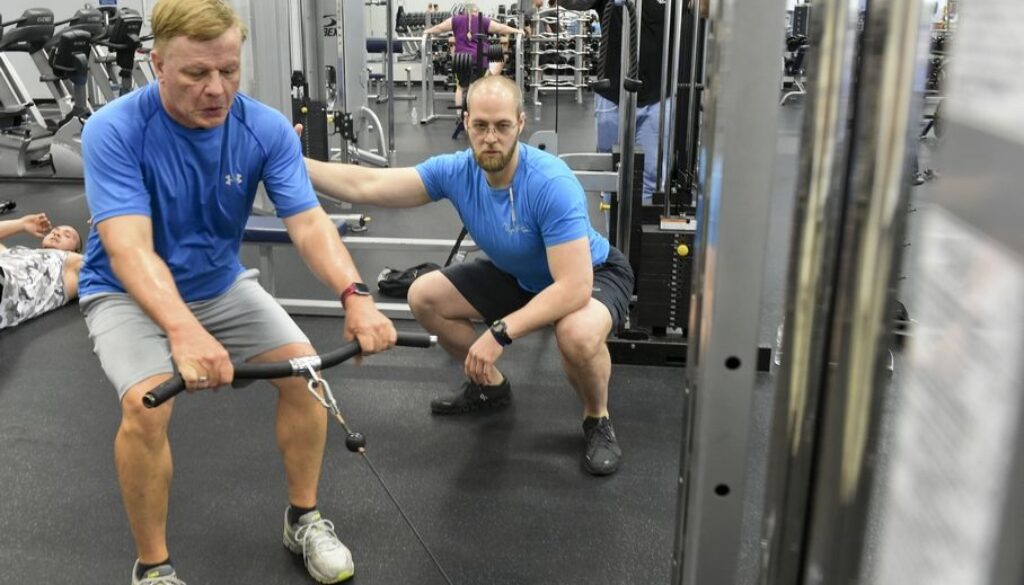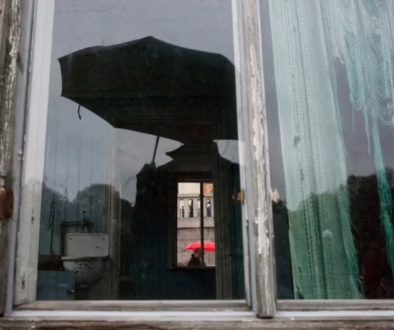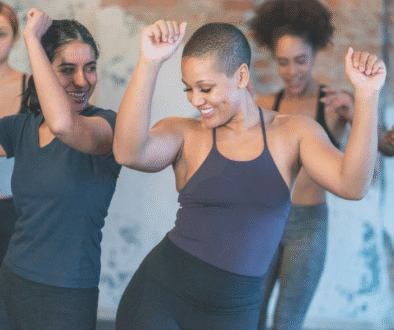“Fitness After 50” by John Monteleone
Fitness After 50
Newly published book written by John Monteleone, CSCS, CSPS, EP-C, FMS Level 2
Head Personal Trainer at Wyomissing Fitness
Chapters 1-4 Excerpts
A Sunday Conversation with My Dad
It’s 6 a.m. on a Sunday and the phone rings.
“Hi Dad! How are you doing?”
My father, 30 years retired Army who has been 10 years out of uniform, replies: “I’m good son. Not much going on here; I wanted to call to see how you are doing. I’m getting ready for the planting season.”
In my opinion, my father was born in the wrong century. His idea about “getting back to the basics” is something that has permeated his personal philosophy as long as I can remember and is evidenced by our early morning talks. No need to burn sunlight when we can speak at 6 a.m., right?
Not one to rest on his laurels after his long military service, and frankly, he probably was just bored, Dad opened his own gunsmith shop, handcrafting flintlock rifles.
After 10 years of successfully running that business, he again got restless and decided to close shop to start following his true passion – farming.
“I have to keep moving son, gotta stay active,” my father says.
“Not much to report on my end, Dad, busy with work as usual,” I reply.
And then, after thinking about it for a moment, I ask: “Dad, you’re 60 years old. Why did you decide to take up farming so late?”
After a beat, he responds: “It keeps me young. I’m outside with the chickens and a rooster. It’s hard work, but I love it. Besides, if I didn’t farm, I would either be dead of boredom or driving three hours a day to exercise with my son.”
Excerpts from Chapter 1: Preparing for Retirement is More Than Just Financial Planning
I am 34 years old – nowhere close to even thinking about retiring. So who am I to be writing a book in which the first chapter is about planning for life after work? Good question.
I’m not a financial planner, a life coach or a lawyer. I’m a personal trainer with a degree in kinesiology. But, as a personal trainer, more than 70 percent of my clients are at least 50 years old – many much older – and more than two-thirds of them are retired.
Over the past decade, I’ve worked with many people who are thinking about retiring; who are newly retired; who are frustrated because, for one reason or another, they can’t retire; or who have been retired for many years. So, I’ve seen and heard a lot about retirement.
And, I’ve learned that everyone who retires has a different idea about what this next stage of their life should look like. Some people pursue the long-held interests they didn’t have time for while working. Some travel to exotic locations, while others stay home and volunteer at the local school to help kids learn to read or deliver meals to homebound folks. Some hit the golf course with a vengeance, while others look forward to taking care of grandchildren.
When people retire, they generally have two big concerns: financial and fitness. They want to be comfortable enough financially to enjoy their retirement years; and fit and healthy enough to be able to do the things they enjoy.
If you’re looking forward to, or already enjoying your retirement, it’s likely that you’ve saved and invested wisely over the years. If that’s the case, I commend you.
But, as important as your financial health is heading into retirement, your physical health is even more important.
Take a minute to picture your perfect retirement. Are you traveling? Gardening? Golfing for hours on end? None of those things can happen if you’re physically inactive, unwell and spending your money and time on doctor visits and prescriptions. I guarantee the retirement you’ve planned for and fantasize about doesn’t include continual hospital stays and afternoons spent at the physical therapy clinic.
Health is your most important asset. To put it into context, by exercising, you’re investing and maintaining your asset, like saving or planning for your financial retirement. By continuing, or starting to exercise, you will be increasing and improving your longevity and quality of life.
If you compare your health to a car, what would your preference be? A high-performance Mercedes or a 15-year-old clunker held together with duct tape and spit? That’s a no-brainer.
Excerpts from Chapter 2: A Brief History of Exercise
My first interests may be kinesiology and fitness training, but I’m also a history enthusiast. So when I started contemplating how the societal concept of fitness has evolved and developed over time, I wanted to learn more about the history of exercise.
What I learned is that over the course of history, exercise has played vital roles in survival and nation building. Let me explain.
In prehistoric times, humans survived by hunting and gathering their food. They didn’t stay in one place, but were constantly on the move, looking for seeds, fruit, nuts, small game and other forms of food.
A bit later, they learned to fish and created better tools that enabled them to track and kill bigger game. Life was based on finding enough food to survive, and finding food required constant movement to accommodate, among other things, changing seasons and shifting animal herds.
Exercise, however, was not limited to prehistoric humans.
The Persian Empire (550-330 BCE)
Physical activity was not only encouraged during this period, it was required of every son born under the empire, because the Persians realized the importance of building and developing soldiers who could defend the empire. Military personnel ranked high in the social structure of the Persian Empire, topped only by kings and priests.
Also, people of the Persian Empire built homes for themselves and constructed roadways. They wove clothing and rugs, and some were accomplished potters. Doing nothing was not an option.
The Ancient Greeks (2500-200 BCE)
In ancient Greece, development of the body was considered as important as development of the mind, resulting in citizens who were the epitome of exercise and fitness.
The ancient Greeks pursued physical perfection and sought to attain it through sports and activities, such as gymnastics, running, jumping and wrestling.
They established palestras, or gyms. The Paidotribes, or fitness trainers, were respected members of society. Ancient Greeks lived by the saying, “Exercise for the body, and music for the soul.” Exercise and music were interwoven in daily life.
Sparta (900s-192 BCE)
Historians tell us that Sparta was quite possibly the most physically fit culture and society in the history of man. Spartans had a keen interest in exercise and fitness, primarily for military purposes.
Spartan men were professional soldiers, and those with the highest levels of fitness, strength and conditioning were most highly regarded in combat.
The Spartan zeal for fitness was even higher than that of the Athenians, which probably contributed to Sparta defeating Athens in the Peloponnesian War (431-404 BC).
Young males in Sparta began a rigorous training regimen as early as age 6 to assure they would mature into healthy and fit soldiers. Females were required to be physically fit as well, with the goal of bearing healthy, strong offspring.
Roman Civilization (200 BCE-476 CE)
According to some historians, the rise and fall of the Roman Empire parallels the rise and fall of the fitness of its people.
During Rome’s period of empire building, the society was heavily invested in physical fitness and exercise. Roman males between ages 17 and 60 were eligible for the military draft and, in order to be prepared for combat, they had to be in peak physical condition. Military training consisted of activities such as running, marching, jumping and discus and javelin throwing.
The superior fitness of the Roman people resulted in Rome conquering nearly all of the Western world.
But after the expansion of the Roman Empire, the emphasis on physical activity declined significantly. Romans had acquired vast wealth and there was affluence throughout the empire.
The process of acquiring material goods and status pieces became priorities, and much of the population preferred entertainment, such as viewing gladiator battles, to physical exercise.
The lavish lifestyle and physical decay eventually took its toll as the Roman civilization fell to the physically superior Barbarian tribes from northern Europe.
Excerpts from Chapter 3: 20th Century: The Rise of the Sedentary Lifestyle
During the middle of the 20th century, a phenomenon regarding work and labor occurred in the United States: We started transitioning from predominantly physically demanding jobs (think steel mills, construction and farming) to jobs that were accomplished while sitting behind desks in offices.
For many people, that meant it was no longer necessary to maintain good physical condition in order accomplish their work. As more workers moved from the mills and mines to office jobs, their level of fitness decreased because they exercised less.
According to the Mayo Clinic, between 1970 and 2000, the number of workers in sedentary jobs doubled. And, with many of us having jobs that require little physical activity, our total screen time has increased dramatically. Even when we’re not bound to a computer for work, many of us are spending our free time watching/streaming TV or glued to social media.
We also drive a lot, whether it’s for business or getting the kids or grandkids from a piano lesson to soccer practice. It’s estimated that the average person spends nearly four hours a day watching television and one hour of driving. Overall, Americans sit for 13 hours every day, and sleep for six to eight hours a night.
That means the average American is active only three to five hours a day. And, by being active, we’re not talking about running or strength training, biking or even walking; we’re just talking about being up and moving about. That’s a pretty startling statistic, don’t you think?
Let’s consider what happens to your body when you sit all day, whether it’s at your desk, in front of your TV or on your front porch.
It doesn’t take much time before your metabolism slows down. Muscles start to get tight, posture compromises, and flexibility and range of motion are out the window. Typically, as the average person’s metabolism slows, the consumption of calories and the volume of food do not. As a result, gradual weight gain ensues.
Sitting for long periods of time also creates significant blood pooling in the lower extremities, which makes it harder for the cardiovascular system to run efficiently. As your muscles stiffen and weaken, posture is affected, and it becomes difficult to support your increased body weight.
Eventually, you may experience an upper and/or lower cross syndrome. With the upper cross, the shoulders roll forward, the upper back is stiff and rounded, the neck protrudes forward and the chest caves in.
With the lower cross, the abdomen is weakened, the lower back muscles and hip flexors shorten and stiffen, and the glutes are weakened. Either of these syndromes can affect balance, range of motion and flexibility.
Your mind and body are continually collecting feedback from your environment. If you are not moving around for the vast majority of your day, your mind and body will adapt accordingly. At the end of the day, you’re not fatigued from hard work; your body and mind are tired from being sedentary. Our changes in lifestyle have yielded some troubling results:
Excerpts from Chapter 4: Myths about Aging, and Why They’re Not True
The dilemma is that you either get old, or you don’t. Most of us, I’m assuming, would choose the former over the latter. The challenge, then, is to grow old while maintaining optimal health and fitness levels. And, that is completely possible.
The human body is an incredible piece of engineering. Highly adaptable and malleable, your body adjusts to and strengthens with activity. When you exercise, your central nervous system (CNS) acts like computer hardware, gathering and interpreting data from your movements and activities. As you continue to exercise, your CNS adapts to the new information it’s receiving and becomes more efficient as your strength increases.
Of course, that works the opposite way, as well. When you’re not active, your body adjusts to that, too, resulting in a slowed metabolism, weight gain, aches, stiffness, joint pain and decreased muscular strength — none of which are any fun.
As we age, our bodies tend to lose some of their plasticity and start to become a bit rigid. You still possess the muscle-skeletal, circulatory and neurological properties to adapt and overcome, it’s just that the ability to adapt takes longer. It’s like switching from a cable modem to dial-up internet: You can still access the web, but you’ll need to be patient.
Staying physically active and exercising regularly can assure that you maintain muscle-skeletal strength and, if your exercise routine has been minimal or lacking, your strength will significantly increase as you age.
It’s true that our bodies experience dramatic physiological changes as we age, and your strength at 50 or 60 might not be what it was when you were 30. But that doesn’t mean that you’re not able to remain active and vital.
Individuals who accept and embrace the aging process are more likely to maintain a positive attitude and be able to take the necessary steps to stay healthy and turn back the clock on aging. They don’t buy into myths of aging. There are lots of variations on “myths of aging,” but here are my top five. Let’s take a look and discover why they are just that . . . myths.
Myth No. 1: Becoming Fragile and Brittle is Inevitable
As a health and fitness professional, this is the No. 1 myth I encounter when working with a client over 60.
The human body becomes fragile for different reasons, namely, physical inactivity, poor diet, genetics and poor lifestyle choices, such as excessive alcohol consumption and sedentary behavior.
Developing and maintaining a physically active lifestyle with daily exercise and proper eating will keep you moving and fit. Muscular strength training and a weight-bearing, cardio-respiratory activity, such as walking, will increase your muscular strength and improve your balance, reducing the risk of osteoporosis and fractures.
Adopting a physically active lifestyle enables you to fight back against the tide of aging and its physiological maladies. By exercising and eating properly, you are being proactive and entering the aging process on your own terms, which is a boost to self-confidence and self-esteem.
The concept of brittle and fragile is an afterthought in those who remain physically active in aging.
Check out John’s new book, independently published and available on Amazon. Part 1 explores what a successful retirement looks like from the angle of health and fitness and an emphasis on why exercise is so important, not only physically, but mentally and emotionally, as well. Part 2 covers the logistics of getting started in an exercise routine, goal setting and establishing a routine, plus reviewing descriptions of exercises that would be beneficial to incorporate in your routine and other fitness tips.



